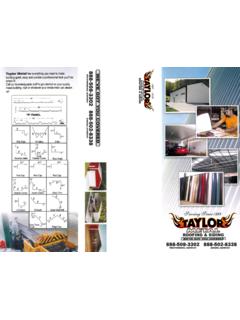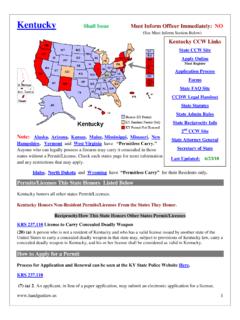Transcription of A Kentucky Homeowner’s Guide
1 A. Kentucky homeowner 's Guide to Notice and Acknowledgements This document was originally reviewed and published in accordance with Environmental Protection Agency policy. Mention of profit-making organizations, trade names, or commercial products does not constitute endorsement or recommendation for use. Copies of the original document can be obtained from: EPA Publications Clearinghouse Box 42419. Cincinnati, OH 45241. Telephone: 800-490-9198. Fax: 513-489-8695. Office of Water Environmental Protection Agency The original document was modified and reviewed for use in the state of Kentucky by the Kentucky Onsite Wastewater Association, Inc., the Kentucky Division of Water, and the Kentucky Cabinet for Health Services. This work was funded in part by a grant from the Environmental Protection Agency under 319(h) of the Clean Water Act through the Kentucky Division of Water to Kentucky Onsite Wastewater Association (Grant # C9994861-01).
2 401 KAR 5:037 requires owners of on-site sewage disposal systems to have a groundwater protection plan for their on-site system. Owners of on-site sewage disposal systems may meet the regulatory requirements by reading this information and using the recordkeeping system located at the back of this Guide . A Kentucky homeowner 's Guide to Septic Systems What's Inside Your septic system is your responsibility .. 1. How does it work? .. 1. Why should I maintain my septic system? .. 4. How do I maintain my septic system? .. 5. What can make my system fail? .. 8. Septic Systems: Do or Don't .. 12. Septic System Recordkeeping .. 13. Our Mission Statement Through education and communication, to elevate the onsite wastewater industry and thereby protect human health, preserve the environment, and improve the quality of life for onsite professionals.. Your Septic System is your responsibility! Did you know that as a homeowner you are responsible for maintaining your septic system?
3 Did you know that maintaining your septic system T op Four Things You can Do to Protect Your Septic protects your investment in your home? Did you System know that you should periodically inspect your system and, if necessary, pump out your septic 1. Inspect your system tank? (every year) and pump your tank as necessary If properly designed, constructed and maintained, (generally every 3 to 5. your septic system can provide long-term, years). effective treatment of household wastewater. 2. Use water efficiently. However, if your septic system is not maintained, you may need to replace it, costing you thousands 3. Don't dispose of of dollars. A malfunctioning system can household hazardous contaminate groundwater, a source of drinking wastes in sinks or water. Don't forget - If you sell your home, your toilets. septic system must be in good working order. 4. Care for your drainfield. This homeowner 's Guide will help you care for your onsite wastewater disposal system.
4 It will help you understand how your system works and what steps you can take, to ensure your system will function properly. To learn more, consult the resources listed at the back of this booklet. A checklist is also included at the end of the booklet to assist you in keeping track of your septic system maintenance. How does it work? Components A typical septic system has four main components: a pipe from the home, a septic tank, distribution box, a drainfield, and the soil. Microbes in the soil digest or remove most contaminants from wastewater before it reaches groundwater. Typical onsite wastewater treatment system A Kentucky homeowner 's Guide to Septic Systems 1. S eptic system aliases: .. On-lot system Onsite system Sewer Line All of your household wastewater exits your home Individual sewage through a pipe to the septic tank. This pipe is called your sewer line. disposal system Onsite sewage Septic tank disposal system Onsite wastewater The septic tank is a buried, watertight container treatment system typically made of concrete, fiberglass, or polyethylene.
5 It retains the wastewater long enough to allow solids to settle to the bottom (forming sludge) and oil and grease to float to the surface (as scum). In the septic tank partial decomposition of the waste material occurs. Baffles and/or a T-shaped outlet in the septic tank prevent the sludge and scum from leaving the tank and traveling into the drainfield area. Screens or filters are also recommended to keep solids from entering the drainfield. To function properly, the screens must be removed and cleaned on a regular basis. Kentucky regulations require new tanks to have a riser with lid at ground surface to allow easy location, inspection, and pumping. This access must be secured, to prevent access by non-authorized persons. Typical single-compartment septic tank with ground-level inspection risers and screen Tip To prevent buildup in the tank, sludge and floating scum may need to be removed by pumping the septic tank.
6 Regular annual inspections and pumping when necessary (generally every 3 to 5 years) will keep your septic system in good working order. A Kentucky homeowner 's Guide to Septic Systems 2. Finding Your System Property Line Your septic tank and drainfield area(s) 5'. should be clearly designated on the as- built drawing for your system. (An as- 5' Soil Absorption Area 25'. built drawing is a line drawing that Septic accurately portrays the system on your Tank C. property and is usually filed with your 10'. 5' r e local Health Department office.) You e k might also see lids or manhole covers Garage for your septic tank. Older tanks are 70'. House often hard to find because there are no D. visible parts. If your septic tank has no 10' r i risers visible, contact an inspector or v e service professional to help you locate Well w a y your septic system. Utility Easement Roadway Drainfield The clarified wastewater exits the septic tank and is discharged into the drainfield for further treatment by the soil.
7 The partially treated wastewater is pushed along into the drainfield for further treatment every time new wastewater enters the tank. If the drainfield is overloaded with too much liquid, it will flood, causing sewage to flow to the ground surface or create backups in plumbing fixtures. This situation prevents treatment of the wastewater. This means you cannot flush your toilet. A reserve drainfield area is required by the state of Kentucky . A reserve drainfield is an area on your property suitable for installation of a new drainfield system if your current drainfield fails. Treat this area with the same care as your present septic system. Soil The wastewater effluent flows to the drainfield, where it percolates into the soil. The soil provides the final treatment where the removal of harmful bacteria, viruses, and nutrients occurs. Suitable soil is necessary for successful wastewater treatment. A Kentucky homeowner 's Guide to Septic Systems 3.
8 Alternative systems Many areas in Kentucky do not have suitable conditions for typical or conventional septic systems. An alternative treatment system may be available for your site. Alternative septic systems use new technology to improve treatment processes and may need special care and maintenance. Some alternative systems use sand, gravel, peat, or plastic media instead of soil to promote wastewater treatment. Some systems may include aerators, disinfection devices, float switches, pumps, and other electrical or mechanical components. Inspection schedules for alternative systems can vary. Check with your local county health department or installer for more information on operation and maintenance needs if you have an alternative system. Not all Kentucky counties have been approved for the installation of alternative systems, so check with your local county Health Department before purchasing a building site. Why should I maintain my septic system?
9 When septic systems are properly designed, constructed, and maintained, they effectively reduce or eliminate most human health or environmental threats posed by pollutants in household wastewater. However, septic systems require regular maintenance or they can fail. Septic systems need to be monitored to ensure that they work properly throughout their service life. Saving money A key reason to maintain your septic system is to save money! Failing septic systems are expensive to repair or replace, and poor maintenance is often the culprit. Having your septic system inspected regularly is a bargain when you consider the cost of replacing the entire system, which may cost thousands of dollars. Your septic tank may need to be pumped (generally every 3 to 5 years), depending on water usage in the home and the size of the system. An unusable septic system or one in disrepair will lower your property value and could pose a legal liability.
10 Protecting health and the environment Other good reasons for safe treatment of sewage include preventing the spread of infection and disease and protecting water resources. Typical pollutants in household wastewater are nitrogen, phosphorus, bacteria, and viruses, some of which can cause illnesses. If a septic system is working properly, it will effectively remove these pollutants. A Kentucky homeowner 's Guide to Septic Systems 4. With 1/4 of homes using septic systems, more than 4 billion gallons of wastewater per day is dispersed below the ground's surface. Inadequately treated sewage from septic systems can be a cause of groundwater contamination. It poses a significant threat to drinking water and human health because it can contaminate drinking water wells and cause diseases and infections in people and animals. Improperly treated sewage that contaminates nearby surface waters also increases the chance of swimmers contracting a variety of infectious diseases.




